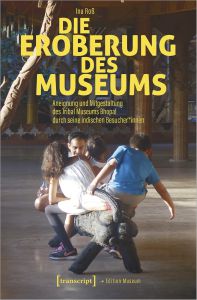Ina Roß, Die Eroberung des Museums. Aneignung und Mitgestaltung des Tribal Museums Bhopal durch seine indischen Besucher*innen [Conquering the Museum. Appropriation and Co-Determination of the Tribal Museum Bhopal by its Indian Visitors], transcript Verlag, Bielefeld, 2023

Die Eroberung des Museums by Ina Roß investigates how the Tribal Museum (founded in 2013) of the City of Bhopal, which lies in the central Indian state of Madhya Pradesh, has been appropriated and also co-determined by its visitors since it opened. This study, published by transcript Verlag in 2023, is an adapted version of a doctoral dissertation submitted to the mdw’s Department of Cultural Management and Gender Studies. The author, who now teaches cultural management and artist marketing at Saarland University and the fine art school Hochschule der bildenden Künste Saar, previously spent five years teaching as a lecturer at the National School of Drama and the university Jamia Millia Islamia in New Delhi. Her qualitatively conceived study is based on an evaluation of visitor statistics, internal museum reports, a visitor register, her own observations of visitor behaviour, and a total of eighty conversations with visitors as well as administrative and art-focused museum personnel ranging from ten to thirty minutes in length that the author conducted between 2015 and 2018. Rather than by way of the museum’s collection, curatorial approach, or administrative practices, the author approaches her research subject above all by analysing the diverse forms of interaction and practical usage that she observed among this museum’s overwhelmingly local visitors. Her ca. 315-page book, which begins with an introduction and a chapter on the employed methodology, is divided into three main parts—the first of which consists in an overview of museums and their various publics in India. Its second part provides a thorough introduction to the Tribal Museum Bhopal. And in its third, most extensive part, the author identifies six categories of use—ranging from use of the museum as a place for a date, as a picnic location, as a location for studying, as a locus of nostalgia and memories, and as a backdrop for selfies to its use as a place of artistic inspiration and as a source of ideas for arts and crafts as well as for everyday activities. From these categories of use, she deduces four distinct appropriative patterns (“Social Colonisation”, “Affective Charging”, “Biographical Enhancement”, and “Cognitive and Productive Reception”) and emphatically highlights their visitor development-related potential in the Indian context. The extensive appendix provides a look at this institution’s organisational culture, an organigram and floor plans, and information on how the indigenous communities that participate in the museum are organised as well as on the museum’s founding commission and its 2018 and 2019 visitor figures. This study of a tribal museum in India will most certainly succeed in drawing increased attention to South Asia’s museum and cultural sector as well as to the diversity of interactive practices on the part of local visitors in the Indian context and beyond.

